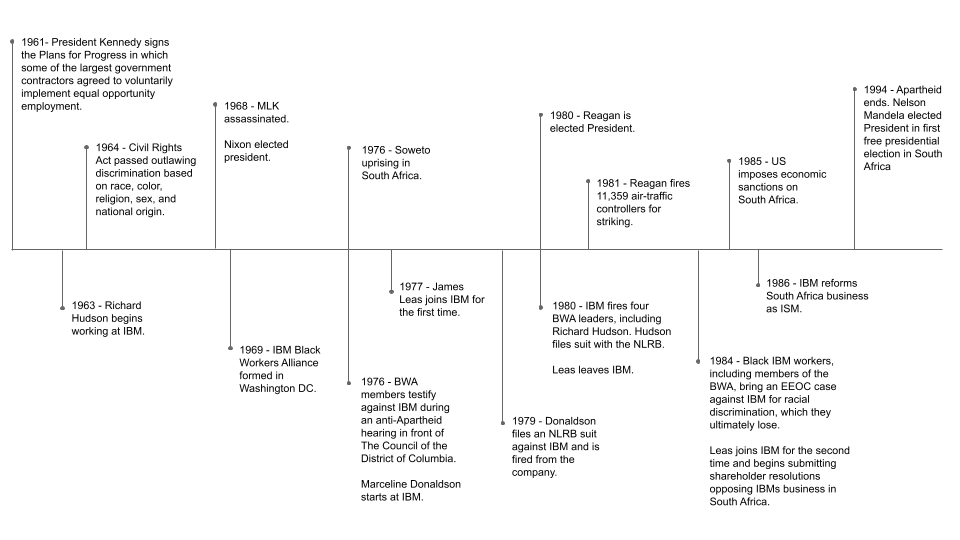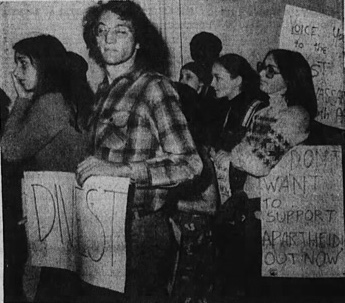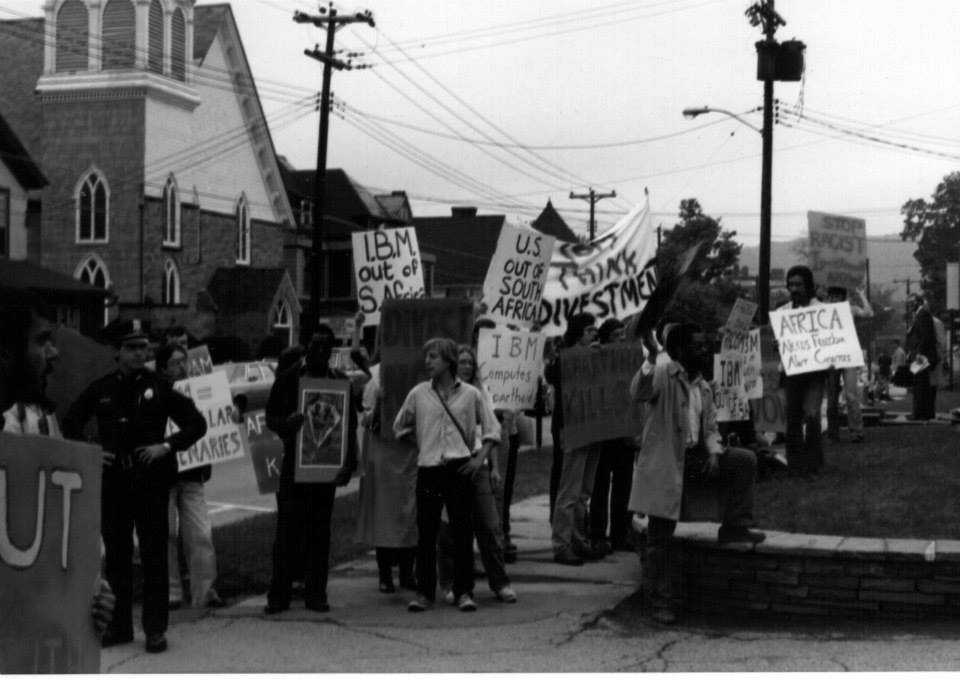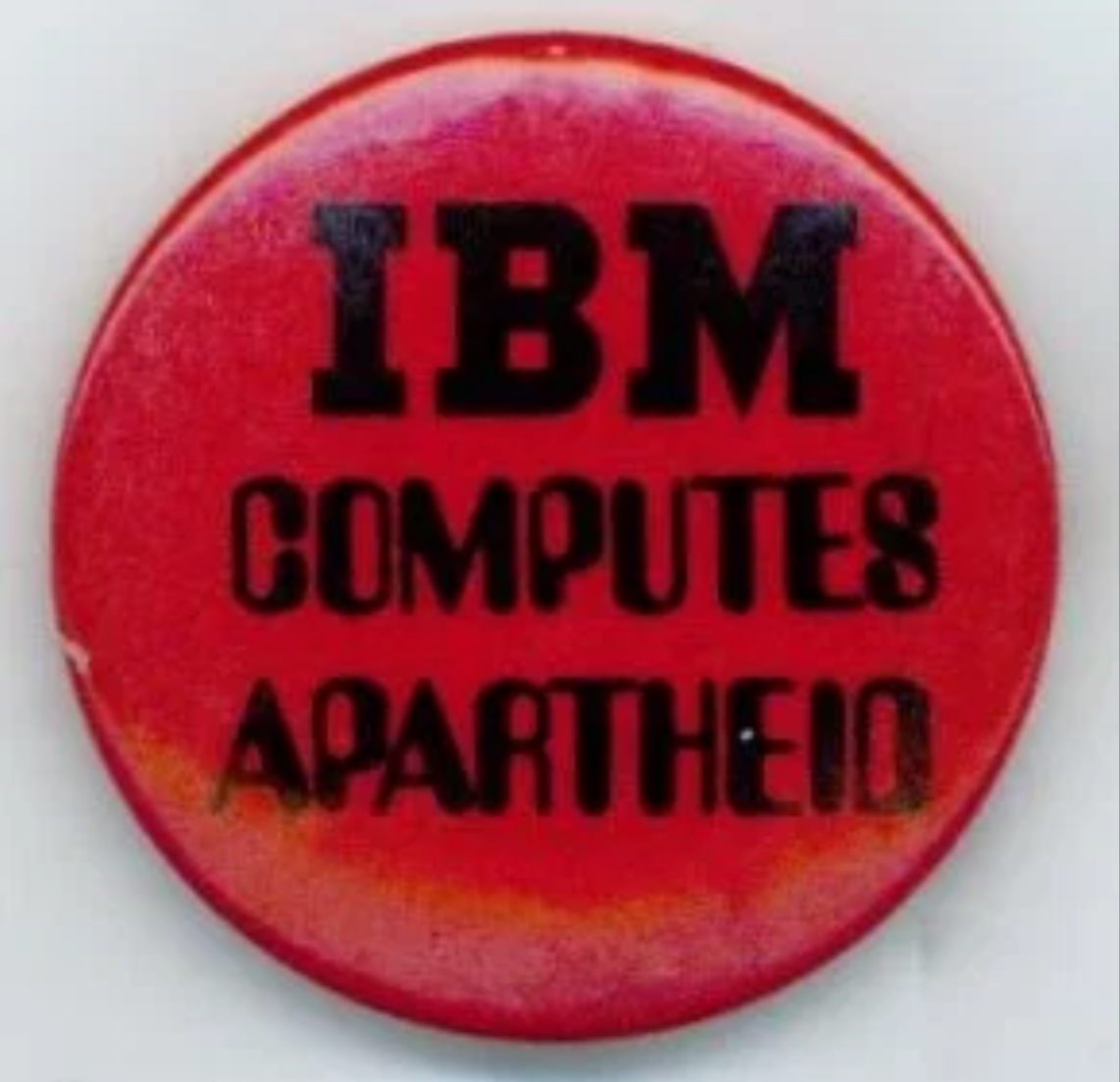Against Apartheid: Lessons on Solidarity
12 Jul 2021
In the final piece in our series on worker organizing at IBM, we share edited excerpts from an oral history interview with James Leas, an engineer and lawyer who began working at IBM in 1977. During his two decades at IBM, Leas used a variety of tactics to pressure IBM to cut ties with South Africa’s apartheid government, organizing shareholders as well as employees in coalition with religious groups and labor unions. Leas’ efforts were innovative and exemplary, and we hope his methods can serve as a useful historical model for modern-day organizing.

IBM Workers United flyer from ~1977 urging employees to speak out against IBM doing business in South Africa. / Source
The Worker’s Perspective
by ann haeyoung
When I started searching for information on the IBM Black Workers Alliance (BWA), one of the first documents I came across involved a BWA member, Kwame Afoh, testifying before The Council of the District of Columbia in 1976 about IBM’s relationship with the apartheid government of South Africa. I then looked for further references to the anti-apartheid work of the BWA, but found very little. In my search, I came across James Leas, a white anti-war activist and IBM employee who was central to a dissident shareholder campaign pressuring IBM to divest from South Africa. I reached out to learn more about his organizing work against apartheid, as well as any encounters he may have had with the BWA.
Leas was an engineer and lawyer who worked at IBM from 1977-1980, and again from 1984-2001. An anti-war activist in his college years, Leas organized against IBM’s collusion with the South African apartheid government during his time at the company. He authored yearly shareholder resolutions from the mid-1980s through the early 1990s condemning IBM’s support of apartheid. After IBM, Leas continued working as a patent lawyer and helped IBM employees affected by mass layoffs file a class action discrimination lawsuit. He continues to organize locally in his community against militarization.
In this series, Richard Hudson, Marceline Donaldson, and James Leas all spoke about how to understand our work and workplace dynamics within larger systemic forces, and how to turn workplace frustrations and complaints into tangible change. Together, their stories demonstrate the power of worker solidarity and the importance of building coalitions.
While this project was focused on documenting the stories of Black worker organizers at IBM, particularly those involved with the IBM Black Workers Alliance, it’s also about the importance of archives as a means of resistance. Archives are political. As workers and organizers, sharing our stories helps us forge connections to the history and the future of labor organizing.

Timeline of major world events (top) and key events in Black worker organizing at IBM mentioned in the interviews (bottom)
Having participated in anti-war protests throughout his college years, Leas dove into organizing immediately after joining IBM.
I got a job at IBM. That was in the spring of 1977. Soon after arriving at IBM, I met up with people in Poughkeepsie, at Vassar College, who were working against apartheid. I started going to meetings with them and suggested that we picket IBM: there was a plant in Poughkeepsie, a big plant where they were putting together mainframe computers. We did that, and my picture ended up on the front page of the Poughkeepsie Journal.
My manager wanted to talk to me about it the next day. But he said, you know what, you’re an American; you have freedom; you’re allowed to participate in public events, and working here is not an impediment. I was in shock to hear that. But he was right. How could it be otherwise? We don’t live in any of these places that are under dictatorship, so why shouldn’t we as employees have the right to speak up on any issues — including ones that have to do with our employer?
It was quite a good experience for me to hear that. I continued to participate in opposition to apartheid. I wrote a long letter to the chairman of the board explaining why I thought IBM should exercise its right to stop selling to South Africa, and to participate in the boycott of South Africa. At the time, IBM was the largest provider of computer technology to South Africa.

Leas at a protest with Vassar students in 1978. Source: Poughkeepsie Journal.
Leas found the shareholder resolution to be a powerful tool to rally workers and give them a voice outside the company, while also providing protection against retaliation from IBM.
I was writing about [IBM’s business in South Africa in op-ed pieces] and I also submitted stockholder resolutions calling on the company to end sales to South Africa. Every year, it was a new resolution with new information and new facts.
[Something that’s useful to know] for people participating in job-related situations where you’re basically opposing management and going public with it: the stockholder resolution gives you a certain level of protection. The SEC [Securities and Exchange Commission] wouldn’t look favorably on management if they punished stockholders who submit resolutions. It looks bad for management if they’re trying to suppress that kind of thing.
The campaigners held rallies at shareholder meeting locations, which attracted local media attention.
Another thing we were able to do with [the resolution] was get a lot of media attention, because it was a unique thing for IBM to have a stockholder meeting in any particular town. They’d move it around every year — it was always in a different town. So the local media would be very interested that a big company like IBM was having its stockholder meeting in their town, and they’d all come out.
We would put out a press release saying we were having a picket line in front of the IBM stockholder meeting. Our picket line would include IBM employees, about 15 church organizations who were against apartheid, a whole range of religious organizations and some unions. We would have this picket line, and we’d have our speakers, and that would be the major topic about the stockholder resolution every year in the local media. What was really interesting to the local media was that IBM employees were speaking up. That was an unusual situation, which made it news.
I think that that organizing campaign was effective, and it may have contributed in some minor way to ending apartheid.

Committee on Southern Africa protest against IBM's role in supporting the apartheid regime in Binghamton, NY, 1979. / Source
Building power and movements both outside the company and within it gave the dissident shareholder campaign broader reach.
The way I organized it, we’d have endorsers and co-sponsors. The co-sponsors were employees. We focused on employees who owned some amount of stock. Almost everybody did, because of the company having an employee stock ownership plan — you could even have a fraction of a share and you could be a co-sponsor. It was up to IBM to decide whether the $2,000 [requirement for co-sponsoring resolutions] was satisfied, but after the first year or so they stopped worrying about that and they just let everybody be a co-sponsor who had some level of shares.
We also had endorsers. People who didn’t own shares, or had just sold their shares, could endorse [instead of co-sponsoring]. We also got prominent people to endorse, including I.F. Stone and Noam Chomsky. I had taken a class with Noam Chomsky when I was at MIT: “Intellectuals and Social Change”. I learned all about how intellectuals don’t really retain their independence — instead, they look to who has power. It was kind of a shock because you’d think they would be less pressured, as a lot of them have tenure as faculty members. But power exerts influence.
So [Noam Chomsky] would endorse it. And we’d get other people: I think we had South African anti-apartheid leaders endorse the campaign. We were looking to show broader support.
And then there was the IBM National Black Workers Alliance, who endorsed the campaign. Many of their members did as well. In one case, when the stockholder meeting was in Pittsburgh, it was actually accessible by car to go from Washington D.C. where [the BWA’s] President was located, and so we all drove up together and participated in the stockholder meeting. I think ten of us from the Washington area went to that particular meeting.
One of the things that I learned was that the more public you are, the better. If we published in the newspaper, if we were interviewed on TV or radio, if we were outspoken, that was okay. As long as we weren’t interfering with customer relations, IBM was okay with it.
IBM made some changes to its business in order to quell opposition, but the anti-apartheid campaigners called them out on the superficial nature of those changes.
IBM tried to make a concession that would make the problem go away. Their approach was, well, we’ll sell our South African division. And they did: they divested from IBM South Africa, the company that was operating in South Africa. That company became an independent company called ISM.
ISM did exactly what IBM had been doing, which was importing computers, selling them to South African banks and corporations, servicing them, upgrading them, and things like that. It was change with no difference.
After IBM did that, our stockholder resolution exposed what had happened, so it didn’t satisfy anybody. We kept doing what we were doing, but now saying, look, stop this, this [divestment] is not stopping sales; it’s just continuing business as usual. That was the attempt that the business community was trying to implement — some kind of concession that would make the issue less of a problem for them without actually doing anything. But you could actually expose that. Especially as an IBM employee, you had a certain platform from which you could speak to the public, because the news media would pay attention [to employees]. Whereas as an ordinary citizen, it’s much harder to get media coverage.
The only time Leas received pushback from IBM was when he directly contacted a customer to discuss IBM’s South Africa business.
The one time that they thought I did interfere with customer relations, they put me on notice to be fired. I was on some kind of a 90-day program, on notice. Once the 90 days were up, I was off notice. In that case I had called up the county manager in Dade County, Florida because Dade County — along with other cities and towns around the country — had passed resolutions giving preference to companies who were not doing business in South Africa. For Dade County, it was a 5% preference. So if there was bidding on a contract, and [your company] was doing no business in South Africa, then even if your bid was as much as 5% higher, you could still win the contract over someone who was doing business in South Africa.
At the time, IBM had sent two Black executives to Dade County to sit down with the county executive. They had told him something that they knew was not true [that IBM was no longer doing business in South Africa]. I was in shock. This isn’t how IBM operates; this is not the way you were supposed to conduct business.
So I called Dade County. I said, “Look, I’ve got my stockholder resolution and the resolution says that IBM is still selling to South Africa. If these executives are telling you that they’re not, why doesn’t IBM dismiss the resolution and say, we’re not selling in South Africa?” Because that’s one of the grounds to have a vote on something. They’re accepting the resolution. [If they weren’t selling to South Africa, the SEC would say] we wouldn’t need to vote on it anymore. But in fact IBM is allowing this to go to a vote, because they are selling in South Africa.
I then called up one of the two executives. I said, “I just spoke to Dade County and they’re saying that you told them something. I think there’s a mistake. Under the business conduct guidelines that we’re supposed to read and sign every year as IBM employees, we’re supposed to correct any misapprehension that we might have made in any communication with anyone outside the company. You may want to call them up and correct it so that they hear it from you and not just from me. “
The next day, I’m called into the location manager’s office. Where I was working at the time was in Manassas, Virginia. It was a huge IBM semiconductor plant, and there were thousands of employees, so it was rare to get called into the location manager’s office. I had never had that opportunity before.
[The manager] told me that I was on notice because I had interfered with customer relations. He didn’t want to hear what I had to say, but I did say that I was correcting, merely correcting, finding out the facts, telling him about the stockholder resolution, and that I reported myself to the executive. It wasn’t like I was trying to keep it a secret or going behind anybody’s back.

Anti-apartheid campaign button with the slogan “IBM COMPUTES APARTHEID.” / Source
Leas continued writing shareholder resolutions until apartheid ended in 1994. He shares his thoughts on the necessity of organizing in the workplace.
If there are enough attempts, people will learn from each other. If people at different companies are engaged and start campaigns, they can actually help each other and learn from each other and build on success. I think that’s what started to happen during the 1930s. There were mobilizations at many different plants, and strikes, and all kinds of events all around the country. People learned from each other and they built organizations. They were coming out of a period where there was an intense attack, assault on people, on all kinds of rights in the 1920s. So it was difficult. Unions were under attack. And suddenly, in the 30s, everything exploded.
I think that now, with the economy and COVID-19 and the terrible disaster of a response the system has had to COVID-19, it’s a failed state. When you have so many people sick and dying … we don’t have a healthcare system. We don’t have a [universal] healthcare system, and [there were] all these layoffs. All these gig economy jobs don’t have healthcare, don’t have a reasonable wage.
This is a system ripe for mass mobilization, mass protest. And the people in the industry are the people to do it. If you’re not in the industry, you cannot lead the movement. You have to be a worker there.
This is one of the skills [that is useful for the job]: you can learn your physics, you can learn your math, you can learn your coding, and you can be super good at all of those, but you also have to be an organizer if you want to be an American worker.
Leas has continued organizing after leaving IBM. He was involved with a class action lawsuit that IBM workers filed against the company for age discrimination, and he has been involved with local campaigns against the US military. He reflects on the importance of combining legal action with mass mobilization for successful campaigns.
You have to go after [the people in power]. You have to have demands, and organize people around those demands. Otherwise, it’s just a complaining society.
Now the other thing is legal action. I’m a lawyer, but legal action has to be done in a way that doesn’t depress the concerted action — which it can do: people wait to see how the legal effort is going; they don’t stay involved. The idea with legal action is to combine the legal calendar with participation. So if there’s going to be a court hearing, or a status conference, or a brief has to be filed, those are occasions where everybody gets involved. You have to make some kind of an event, so that we’re not just waiting. No, just the opposite: this is our springboard for more events.
We’ve seen that in a campaign I’m working on now, where the politicians in Vermont decided that the airport in the city of South Burlington is going to be the place for F-35 jets, so we have 20 of them there now. We had a huge campaign to oppose it. We even had a vote in the town that owns the airport — it’s actually Burlington that owns the airport in South Burlington — and we won. At the vote on the referendum, we won, with 55% [voting] to cancel it. But the politicians just foisted it on them anyway.
We’ve had two lawsuits [contesting the decision]. We’ve lost them both. Part of the reason I think we lost was because our campaign demobilized during these hearings. The only pressure on the court is from the establishment, because that’s where these judges come from — they’re picked because they have associations, because they’re part of the establishment. They have judicial nominating boards with a lot of prosecutors and establishment types. People from the legislature and the governor pick who’s nominating the judges. So it’s very difficult to win in court unless you can balance the pressure.
In other words, you’re not trying to influence the courts; you just want them to do the right thing under the law because they’re not going to do that unless there’s some balancing pressure to do it. You wouldn’t bring the case unless you had the law on your side — nobody is going to be a plaintiff in a case if they have a losing case. So why do you lose? It’s because they come up with some reasoning — it doesn’t even have to be logical reasoning — to defeat you. So you need to counterbalance that establishment pressure. It isn’t enough to file a suit, you have to have a strategy to keep people mobilized and in the streets and in action, to make your case as vividly as possible in the public mind.
This is our final post in the series In Search of the IBM Black Workers Alliance. Thank you to Marley Pulido Vargas for editing this week’s story. And thank you to Tamara Kneese, Kaylen Sanders, Marley Pulido Vargas, Wendy Liu, Danny Spitzberg, and the entire TWC Newsletter team for their support of this series overall. Finally, thank you for reading! If you have ideas for how to connect with more individuals involved in Black worker organizing at IBM, contact me at ann@a-tbd.com.